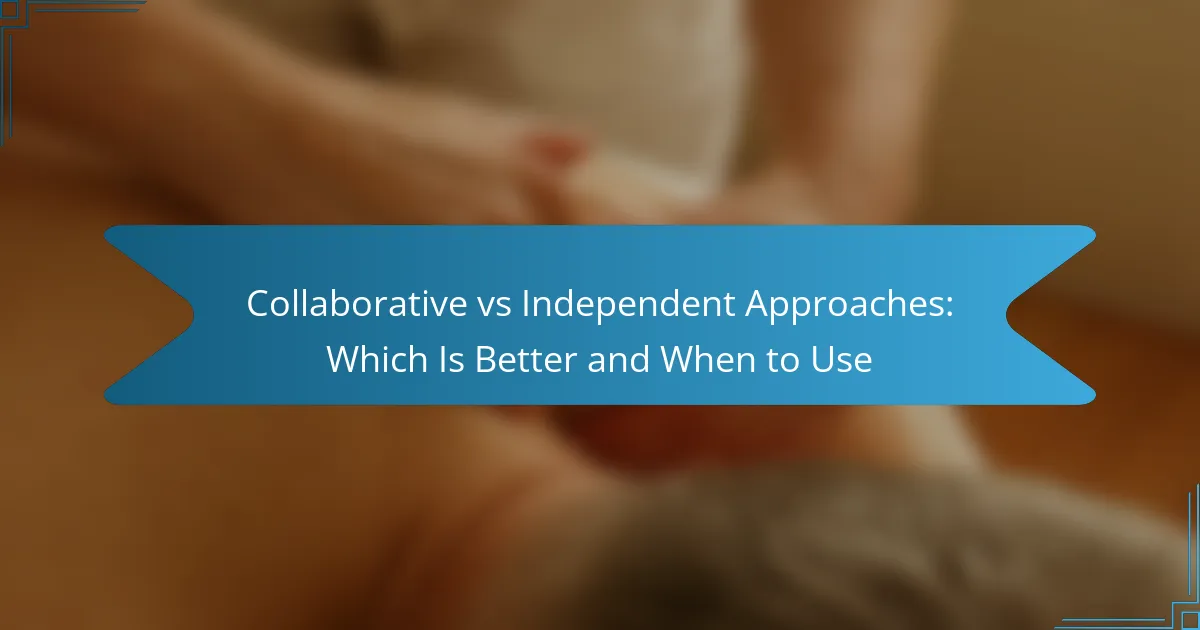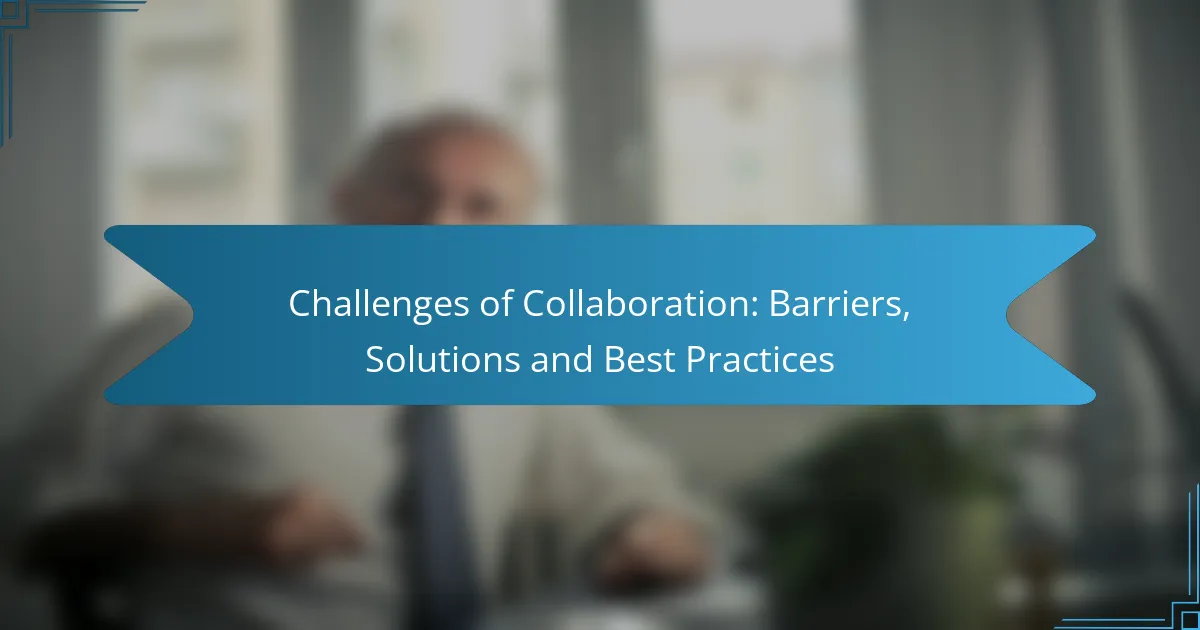Choosing between collaborative and independent approaches depends on the nature of the task and the desired outcomes. Collaborative methods enhance creativity and problem-solving through teamwork, while independent approaches offer autonomy and efficiency for tasks requiring personal initiative. Understanding when to leverage each approach can significantly impact productivity and innovation in various work environments.

What Are the Benefits of Collaborative Approaches?
Collaborative approaches offer numerous advantages, including enhanced creativity, improved problem-solving, and stronger relationships among team members. These benefits can lead to more innovative solutions and a more cohesive work environment.
Enhanced creativity
Collaboration fosters an environment where diverse ideas can flourish. When individuals from different backgrounds and expertise come together, they can generate unique concepts that may not emerge in isolation.
To maximize creativity, encourage open dialogue and brainstorming sessions. Techniques like mind mapping or design thinking can help teams explore various perspectives and refine their ideas.
Improved problem-solving
Collaborative approaches enhance problem-solving by pooling knowledge and skills. Teams can tackle complex issues more effectively by leveraging the strengths of each member.
Consider using structured problem-solving frameworks, such as the Six Thinking Hats method, to guide discussions and ensure all viewpoints are considered. This can lead to more comprehensive solutions that address underlying issues.
Stronger relationships
Working collaboratively helps build trust and rapport among team members. As individuals share their insights and experiences, they develop a deeper understanding of one another, which can strengthen team dynamics.
To cultivate these relationships, prioritize team-building activities and regular check-ins. This fosters a supportive atmosphere where members feel valued and connected.
Shared resources
Collaboration allows teams to share resources, such as tools, knowledge, and time, leading to increased efficiency. By pooling resources, teams can reduce duplication of effort and optimize their workflows.
Implementing collaborative tools, like project management software, can streamline communication and resource allocation. This ensures everyone has access to the necessary materials and information to succeed.
Increased accountability
Collaborative approaches promote accountability among team members. When individuals work together, they are more likely to hold each other responsible for their contributions and deadlines.
Establish clear roles and expectations at the outset of a project. Regular progress updates can help maintain accountability and ensure that everyone is aligned with the team’s goals.

What Are the Benefits of Independent Approaches?
Independent approaches offer several advantages, particularly in environments that prioritize personal initiative and efficiency. These benefits include greater autonomy, faster decision-making, and enhanced personal accountability, making them suitable for specific tasks and projects.
Greater autonomy
Independent approaches provide individuals with the freedom to make decisions without needing consensus from a group. This autonomy allows for creative solutions and innovation, as individuals can explore ideas without restrictions. For example, a freelance designer can choose their projects and methods, leading to unique outcomes that reflect their personal style.
Faster decision-making
When working independently, decisions can be made quickly since there is no need to consult with others. This speed is crucial in fast-paced environments where time is of the essence. For instance, a software developer can implement changes immediately based on user feedback, improving the product without delays caused by group discussions.
Personal accountability
Independent approaches foster a strong sense of personal accountability, as individuals are responsible for their outcomes. This responsibility can motivate individuals to perform at their best, knowing that their efforts directly impact results. In a sales role, for example, a salesperson’s success hinges on their individual performance, driving them to exceed targets.
Focused expertise
Working independently allows individuals to hone their specific skills and expertise without the distractions of group dynamics. This focus can lead to higher quality work and deeper knowledge in a particular area. For example, a researcher may choose to work alone to delve deeply into a niche topic, producing more thorough and insightful findings.
Reduced conflict
Independent approaches minimize the potential for conflict that can arise in collaborative settings. When individuals work alone, they avoid disagreements over differing opinions and methods. This can lead to a more harmonious work environment, as seen in situations where team members have contrasting styles that may not mesh well.

When Should You Use Collaborative Approaches?
Collaborative approaches are best utilized when the complexity of a task requires diverse perspectives and skills. These methods foster teamwork and can lead to more innovative solutions, making them ideal for specific scenarios.
Complex problem-solving scenarios
In complex problem-solving situations, collaboration can harness the strengths of various team members, leading to more effective solutions. For instance, when dealing with intricate technical issues, pooling knowledge from different experts can uncover insights that an individual might miss.
Consider using collaborative tools like brainstorming sessions or shared digital platforms to facilitate discussion and idea generation. This approach can significantly enhance problem resolution speed and effectiveness.
Team-based projects
Team-based projects benefit greatly from collaborative approaches as they require input from multiple stakeholders. Assigning roles based on individual strengths allows for a more efficient workflow and ensures that all aspects of the project are addressed.
Establish regular check-ins to maintain alignment and encourage open communication. This can prevent misunderstandings and keep the project on track, ultimately leading to a more successful outcome.
Creative brainstorming sessions
Creative brainstorming sessions thrive on collaboration, as diverse viewpoints can spark innovative ideas. Engaging a group in a free-flowing discussion can lead to unexpected solutions and creative breakthroughs.
To maximize effectiveness, set clear objectives for the session and create a safe space for all ideas to be shared. Techniques like mind mapping or round-robin brainstorming can help structure the conversation and ensure participation from everyone.
Cross-functional initiatives
Cross-functional initiatives often require collaboration across different departments, making it essential to leverage diverse expertise. This approach can lead to holistic solutions that consider various aspects of a challenge.
Encourage regular collaboration meetings and utilize project management tools to keep everyone informed and engaged. This helps to build a shared understanding of goals and fosters a culture of teamwork across the organization.

When Should You Use Independent Approaches?
Independent approaches are best utilized when tasks require quick decision-making, specialized skills, or individual accountability. These methods allow for focused effort and can lead to faster results in specific scenarios.
Time-sensitive tasks
For tasks that have tight deadlines, independent approaches can be more effective. When time is of the essence, relying on an individual to make swift decisions can prevent delays that often occur in collaborative settings. For instance, a software developer fixing a critical bug may need to act quickly without waiting for group consensus.
Consider setting clear deadlines and expectations to ensure that the individual remains focused and productive. Avoid overloading them with additional tasks to maintain efficiency.
Specialized skill requirements
Independent approaches shine when a project demands specific expertise that not all team members possess. For example, a graphic designer may need to create a unique logo that requires advanced design skills. In such cases, allowing the expert to work independently can yield higher quality results.
It’s essential to identify the right individual for the task based on their skill set. Providing them with the necessary resources and autonomy can enhance their performance and creativity.
Individual performance assessments
When evaluating individual contributions, independent approaches are crucial. They allow for clear accountability, making it easier to assess performance based on specific outcomes. For example, sales targets can be assigned to individuals rather than teams, providing a straightforward measure of success.
Ensure that performance metrics are well-defined and communicated. This clarity helps individuals understand expectations and encourages them to take ownership of their work, leading to improved results.



